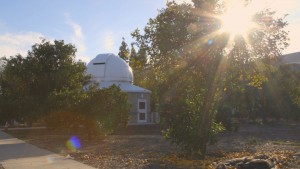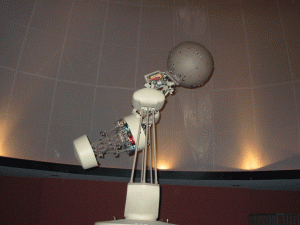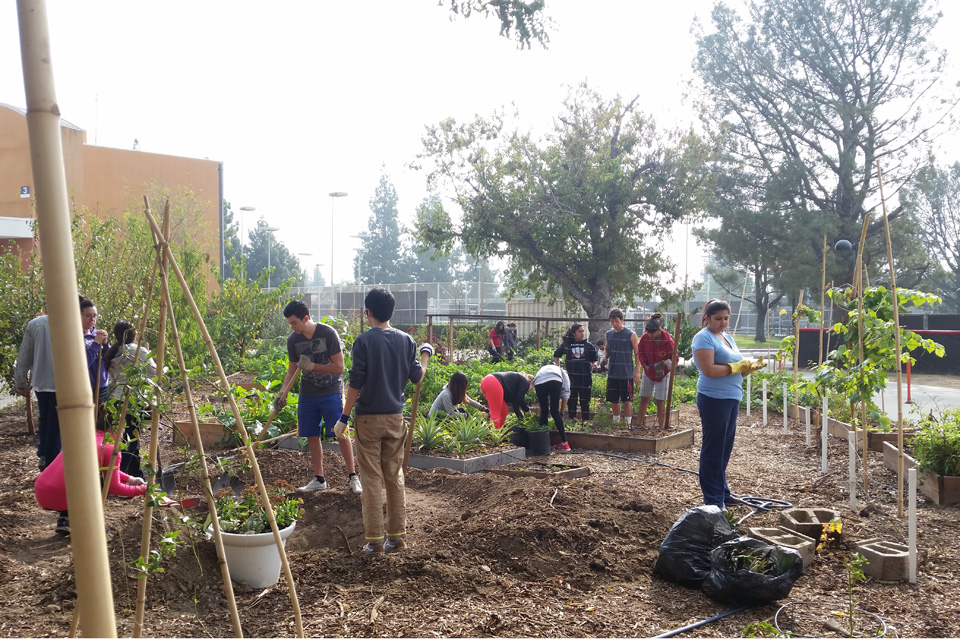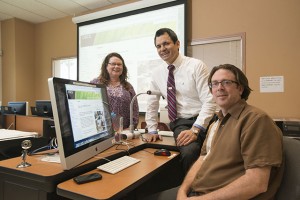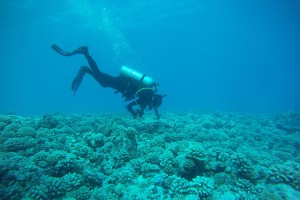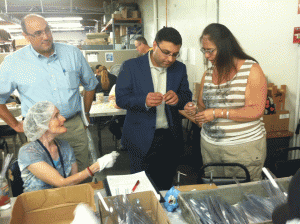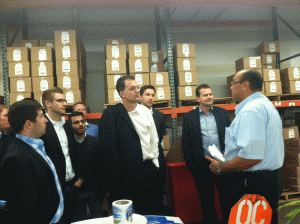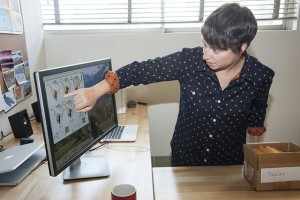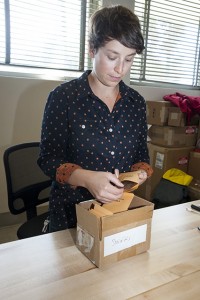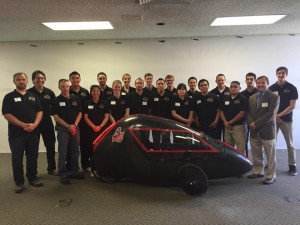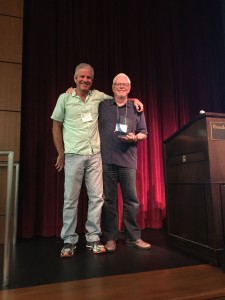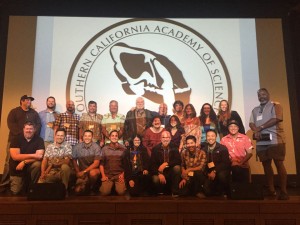![]()
Unmanned aerial vehicles, a steel bridge, a social networking website for gamers, a concrete canoe and a human-powered tricycle — all these incredible creations and more were on display at the Seventh Annual Senior Design Project Showcase at California State University, Northridge on April 15.
Students from every department of the College of Engineering and Computer Science had worked tirelessly on these projects, some since the beginning of the spring 2016 semester and some as part of a three-year plan, while others worked to improve the projects that had been constructed in 2015, such as the CSUN Human-Powered Vehicle Challenge team.
“Last year, the rider actually crashed the bike when we went to competition,” said Rachel Foreman, a mechanical engineering senior. “So, the first thing we looked at when we started work on this tricycle was how we could make it easier for the rider to use, and how we could make sure the brakes would work efficiently. We also looked into the general health and fitness of our riders, as that played a big part in the competition last year as well.”
The event began with teams giving a 10-minute oral presentation on their research to a panel of judges. The panels consisted of professional engineers, who evaluated the teams’ clarity, methodology, project completeness, ability to articulate points and ease with handling the question-and-answer portion of the presentation. The teams that scored the highest overall in these categories were honored at a ceremony at the end of the event.
The second part of the showcase was a gallery, where the teams presented their designs in a more general setting. One group, the CSUN Concrete Canoe Team, already had taken its finished product to a competition, but that didn’t stop them from pulling out all the stops for their booth. They were given a Game of Thrones theme by CSUN on which to base their floor presentation, and not a single detail was overlooked, whether it was the canoe painted with dragon artwork or the rustic jars containing the different materials that made up the canoe. The display was a fantastic opportunity for members of the team to use their creativity to demonstrate how much effort had gone into constructing the canoe.
The CSUN Steel Bridge Team also made an appearance at the showcase. Only weeks away from a competition that will determine if the hard work the team members had dedicated toward the project will pay off, Luis Molina, a civil engineering senior, was hopeful about the team’s chances of winning.
“Last year there were some hiccups with the design, but this year we pulled out all the stops to make sure those same flaws didn’t appear again,” Molina said. “Working on this project and the experience you get from it is great. It really takes the lessons you learn in a class and applies them to a real-life setting. I used to sit in class and say, ‘Oh, that’s just a number or a part of a design.’ But now I get to see where it fits in and how different parts of a design work.”
The end of the day brought an awards ceremony that exemplified the respect that the students and faculty shared for one another. Walking out to the ’80s hit Eye of the Tiger, Dean of the College of Engineering and Computer Science S.K. Ramesh spoke about how proud he was to see students undertake these kinds of projects, and how grateful he was to everyone who participated. He recognized the teams and individual judges for their commitment to the event.
“It was no accident that this event occurred today,” Ramesh said. “It is the culmination of a lot of hard work from everybody — from students to faculty, to our wonderful judges — and we can all take pride in the work we see today.”
Here is a summary of all the winners from the showcase, with students and faculty advisors from each team listed:
Grand Prize
CSUNSat1: Armen Arslanian, Rosy Davis, Sandra Dheming Lemus (CS), Timothy Friedman (CS), Gary Gamble, Cesar Garcia (CS), Nereida Herrera, Matthew Ingram, Phuoc Ma, Priya Malavia (CS) (Captain), Jobeth Palacio, Clifford Williams
Faculty Advisors: Sharlene Katz, James Flynn, Adam Kaplan, David Schwartz
Oral Presentation First-Place Winners
Civil Engineering & Construction Management Department
ADA-Compliant Accessory Dwelling Unit David Boyajian, Sami Maalouf, Tadeh Zirakian, Michele Glidden (Captain), Razan Khalil, Kevin Liu, Andrew Slusser, Anthony Talebian
Faculty Advisors: David Boyajian, Sami Maalouf, Tadeh Zirakian
Computer Science Department
Learning, Classifying and Recognizing Bot (LCAR Bot): Steve Delgado, Jake Hanvey, Thomas Jentis, Karanvir Panesar (Captain), Edwin Portillo, Hovig Shahbazian, Nathaniel Wilson, Bryan Wong
Faculty Advisor: Nhut Ho
Electrical & Computer Engineering Department
Modular Solar Powered Water Pump System Jose Baez (Captain), Joel Fischetti, Jireh Christine Imperial, Brian Lee, Jong Jin Lee, Edwin Rebollo
Faculty Advisor: George Law
Manufacturing Systems Engineering & Management Department
CSUN Cloudponics Hyunjin Kim, Michael Mora (Captain), Navjeevan Sandhu, Rodrigo Soltero
Faculty Advisor: Bingbing Li
Mechanical Engineering Department
2016 Human-Powered Vehicle Challenge: Brian Albarracin, Alan Alcocer, Benjamin Bell, Daniel Cabrera, Eric Figueroa, Rachel Foreman, Mihran Kechichian, John Kok, Armando Lagunas, Jonathan Lo, Alexis Marquez, Cassandra Mathison, Kevin Matsuno, Steven Molumby, Nancy Nodal, Angel Sevilladiaz, Mark Shipman, William Steed, Nami Taghavi, Robert Timm, Robert Vallet (Captain)
Faculty Advisor: Aram G. Khachatourians
Project Display First-Place Winners Per Department
Civil Engineering & Construction Management Department
Concrete Canoe: Catherine Adrover, Daniel Akmakjian, Gabriel Bonilla, Dannick Castaneda, Phat Duong (Captain), Cristian Duran, Julio Iglesia, Sara Lopez, Joe Medina, Valeria Padilla, Ernesto Pedroza, Jecsan Perez, Joel Plascencia, Sam Potts, Claris Rivera, Paul Rivera, Hani Salhab, Miguel Sanchez, Jose Sanchez, Nicole Thompson, Soledad Tlamasico, Francisco Villalobos, Julie Yin, Nikki Zulueta
Faculty Advisors: Rais Ahmad, David Boyajian, Sami Maalouf, Tadeh Zirakian
Computer Science Department
PartyQ: Frank Addelia, Stefan Eng, Marco Jonker (Captain), Alex Kolesnik, Andrew Maynard, Narbeh Movsesian
Faculty Advisor: Steve Fitzgerald
Electrical & Computer Engineering Department
CSUN SAT1: Armen Arslanian, Rosy Davis, Sandra Dheming Lemus (CS), Timothy Friedman (CS), Gary Gamble, Cesar Garcia (CS), Nereida Herrera, Matthew Ingram, Phuoc Ma, Priya Malavia (CS) (Captain), Jobeth Palacio, Clifford Williams
Faculty Advisors: Sharlene Katz, James Flynn, Adam Kaplan, David Schwartz
Manufacturing Systems Engineering & Management Department
CSUN Cloudponics: Hyunjin Kim, Michael Mora (Captain), Navjeevan Sandhu, Rodrigo Soltero
Faculty Advisor: Bingbing Li
Mechanical Engineering Department
2016 Human-Powered Vehicle Challenge: Brian Albarracin, Alan Alcocer, Benjamin Bell, Daniel Cabrera, Eric Figueroa, Rachel Foreman, Mihran Kechichian, John Kok, Armando Lagunas, Jonathan Lo, Alexis Marquez, Cassandra Mathison, Kevin Matsuno, Steven Molumby, Nancy Nodal, Angel Sevilladiaz, Mark Shipman, William Steed, Nami Taghavi, Robert Timm, Robert Vallet (Captain)
Faculty Advisor: Aram G. Khachatourians

